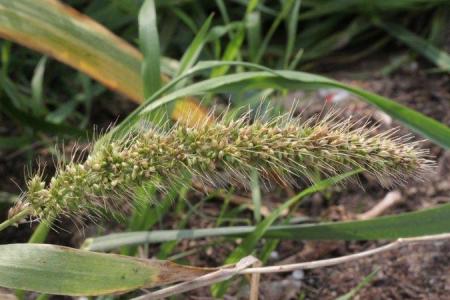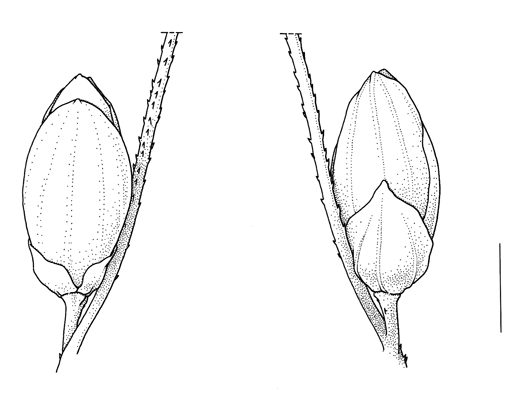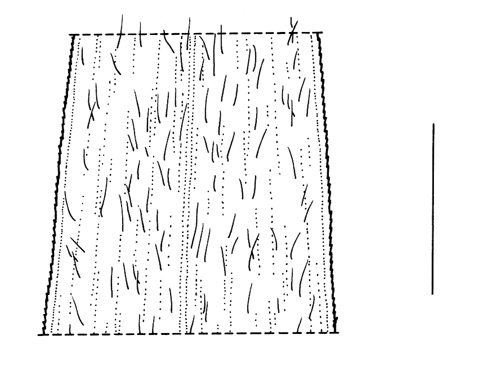2. Setaria faberi R.A.W. Herrmann (syn.: S. macrocarpa Luchnik) (As.) – A rather frequent grain alien, especially as a contaminant in American soybeans. Up to present apparently only found in Flanders, mainly in port-areas: near granaries, unloading quays,… and by railway tracks and highways. In such habitats usually rather ephemeral. However, Setaria faberi is also an increasingly naturalised weed in maize fields in many parts of Flanders (Hoste 2006). It was first recorded by a sandy road verge in Turnhout in 1977 but remained unrecognised until 1994 due to confusion with Setaria viridis. In Belgium Setaria faberi – originally confined to China – is introduced from its North American secondary distribution area.
All Belgian (as well as all European and North American) populations of Setaria faberi are characterised by softly hairy upper leaf surfaces. As a matter of fact, in eastern Asia this species is rather variable and chiefly distinguished from the similar Setaria viridis by a shorter upper glume, thereby clearly exposing the tip of the upper lemma. Leaf blades can be either glabrous or softly hairy adaxially (Shouliang & Phillips 2006). Forms with hairy leaf blades have been segregated as Setaria macrocarpa (Jehlík 1978). This binomial should be applied to the Belgian populations if this taxon would be reconsidered at specific rank. A recent revision of Old World Setaria includes it in the synonymy of S. faberi (Morrone & al. 2014).
The taxonomic value of leaf blade hairyness is questionable. In North Africa (and probably elsewhere as well) Setaria adhaerens often has leaves with hairy leaf surfaces that are identical with those encountered in S. faberi.
 |
 |
 |
 |
Selected literature:
Banfi E. (1989) Osservazioni sulle specie italiane del genere Setaria P. Beauv. (Poaceae). Atti Soc. Ital. Sci. Nat. Museo Civ. Storia Nat. Milano 130(13): 189-196.
Doyon D. (1988) Extension de la répartition geographique de Setaria faberi au Quebec., Naturaliste Canad. 115: 125-129.
Dirkse G.M., Reijerse A.I. & Abbink-Meijerink C.G. (2001) Setaria faberi (Chinese naaldaar) in Nederland over ‘t hoofd gezien. Gorteria 27(5): 109-114.
Gregor T. (2006) Setaria faberi Herrm. und Echinochloa muricata (P. Beauv.) Fernald in Mais-Äckern um Vechta. Osnabrücker Naturwiss. Mitt. 32: 53-58.
Hoste I. (2006) Setaria viridis. In: Van Landuyt W., Hoste I., Vanhecke L., Van den Bremt P., Vercruysse W. & De Beer D., Atlas van de flora van Vlaanderen en het Brussels gewest. Instituut voor Natuur- en Bosonderzoek, Nationale Plantentuin van België en Flo.Wer: 828.
Hoste I. & Verloove F. (2001) De opgang van C4-grassen (Poaceae-Paniceae) in de snel evoluerende onkruidvegetaties in maïsakkers tussen Brugge en Gent (Vlaanderen, België). Dumortiera 78: 2-11.
Hügin G. (2010) Panicum dichotomiflorum, P. hillmanii, (P. laevifolium), P. miliaceum subsp. agricola, P. miliaceum subsp. ruderale und Setaria faberi in Südwestdeutschland und angrenzenden Gebieten. Ber. Bot. Arbeitsgemeinschaft Südwestdeutschl. 6: 31-68.
Jehlík V. (1978) Über die fortschreitende Naturalisation der Art Setaria faberi Herrmann in der Tschechoslowakei. Acta Bot. Slov., Acad. Sci., ser. A 3: 57-64.
Jehlík V. (1989) Zweiter Beitrag zur synanthropen (besonders Adventiv-) Flora des Hamburger Hafens. Tuexenia 9: 253-266.
Maslo S. & Šarić Š. (2018) Giant Foxtail (Setaria faberi, Poaceae): a new alien species in the flora of Bosnia and Herzegovina. Phytologia Balcanica 24(1): 51-54. [available online at: http://www.bio.bas.bg/~phytolbalcan/PDF/24_1/PhytolBalcan_24-1_07_Maslo_...
Nawrath S. & Alberternst B. (2012) Grosse Bestände von Setaria faberi an der Autobahn A 94 östlich Ampfing. Hoppea 72: 69-78.
Prunier P., Schneider C. & Lambelet C. (eds.) (2008) Note de floristique genevoise 98. Nouvelle observation de Setaria faberi R.A.W. Herrmann en Suise. Saussurea 38: 67-75.
Scholz H. (1964) Zur Gramineeflora Mitteleuropas II. Ber. Dtsch. Bot. Ges. 77: 145-160.
Shouliang C. & Phillips S.M. (2006) Setaria. In: Zhengyi W. & Raven, P.H. (eds.), Flora of China, vol. 22: 531-537. Science Press, Beijing & Missouri Botanical Garden Press, St. Louis.
Verloove F. (2002) Ingeburgerde plantensoorten in Vlaanderen. Mededeling van het Instituut voor Natuurbehoud n° 20: 227 p.
Verloove F. & Vandenberghe C. (1995) Nieuwe en interessante voederadventieven voor de Belgische en Noordfranse flora, hoofdzakelijk in 1994. Dumortiera 61-62: 23-45.

